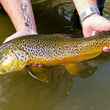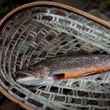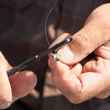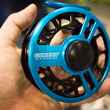We've been talking a lot about streamer tactics lately, with an eye on improving on-the-water success while fishing streamers. Almost all of the tactics we've highlighted have been founded on the same basic premise: streamers are intended to imitate prey that swims, and getting better at fooling fish with them means getting better at making your streamer look and act like the real deal, being an active predator and doing more than just covering water with a swung fly. And while we've relayed many ways to get better at doing just that, we've yet to talk about what many seasoned streamer anglers consider the most deadly streamer tactic of all: the jerk-strip.
Steamer experts like Kelly Galloup and Gary Borger have been talking about the jerk-strip for years, noting its effectiveness above all other tactics and its penchant for producing the most feverish of strikes from the biggest of trout. If that sounds good, then its time you made yourself familiar with the jerk-strip. Along with its effectiveness also comes difficulty, however. The jerk-strip retrieve is a very active retrieve that requires precise timing to master in order to produce the most accurate imitation of a fleeing baitfish.






























